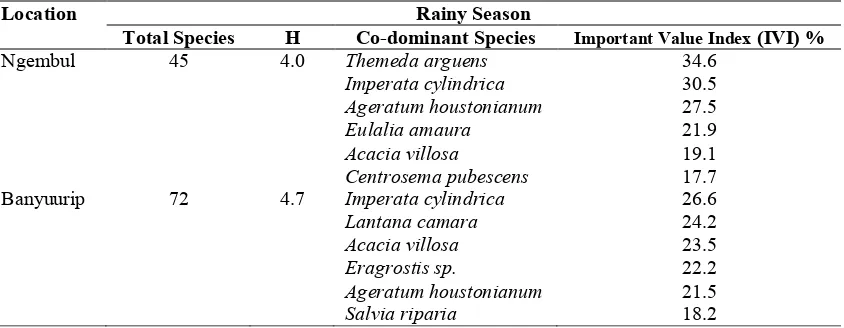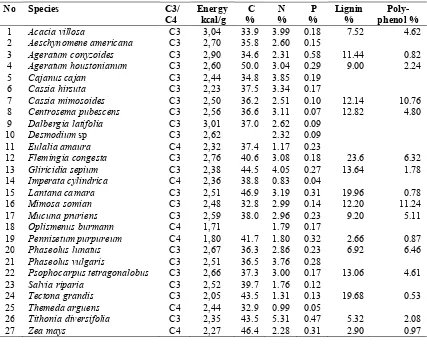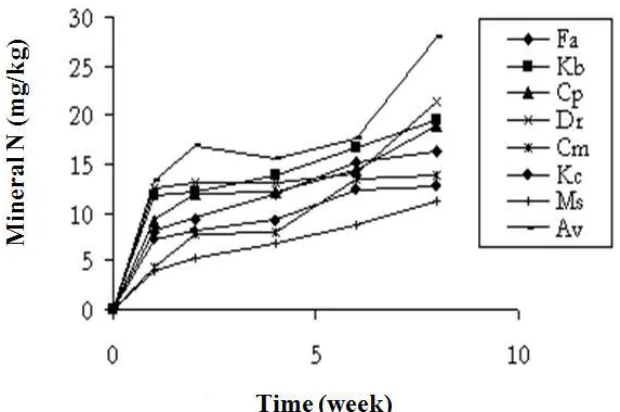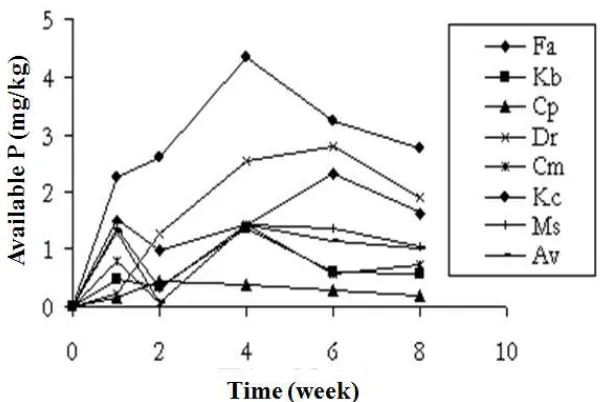ISSN: 2339-076X, Volume 2, Number 2 (January 2015): 313 - 318 DOI:10.15243/jdmlm.2014.022.313
Research Article
Diversity of drought-resistant plants and the benefits of their biomass
for improving fertility of a degraded soil of Brantas River Basin
E. Arisoesilaningsih
1*, Soejono
2 1Faculty of Science, Brawijaya University, Jl Veteran-Malang 65145, Indonesia
2National Botanical Garden, Purwodadi, Pasuruan, Indonesia
*corresponding author: [email protected]
Abstract:
In support of healthy agriculture development to improve farmer’s prosperity status, soil remediation and land conservation efforts maybe relied on the use of biomass of local vegetation. Results of field exploration conducted at Brantas Watershed of East Java indicated that there were at least 154 species of undergrowth scrubs, 47 species of agriculture-plantation crops, and 59 species of road shelter trees. The native undergrowth vegetations had undergone enormous seasonal variations. Biomass of predominance vegetations, e.g. Psophocarpus tetragonolobus, Phaseolus lunatus, Flemingia, Mimosa somian, Acacia villosa, Cassia mimosoides, Mucunacould potentially be used as organic matter sources to improve availability of nitrogen and phosphorus in soils. The amount of nitrogen and phosphorus contributed of the plant biomass significantly correlated with quality of the biomass.Keywords: biomass, plant diversity, soil remediation
Introduction
Brantas river basin has an area of 11,800 hectares and a total length of 320 km. River flow comes from the south side of Mt. Arjuno and ends in the Madura Strait. Calcareous critical land of the Brantas river basin covering the area of Malang, Blitar, Tulungagung and Trenggalek Regencies reach 92,000 ha. The topography of the land is flat, undulating, hilly, slope of 5-60%, moderate to high levels of erosion during the rainy season and dry during the dry season (Utomo, 1989).
The Brantas River Basin land survey team (1988) observed that most of the basin has a shallow soil solum, low soil fertility, low N, P, Mg and Fe. This situation is caused by low soil organic matter content (less than 1%). To maintain soil organic matter content of 2%, organic matter inputs in the form of crop residues around 8-9 t / ha / year is required (Hairiah et al., 1998). However, to obtain plant residues in large numbers in the area is very difficult. Therefore, it is necessary to find an alternative to utilizing the potential of local plant biomass as source of organic matters. Some plants in the dry season
role of each plant species, the genetic potential of each species should be utilized according to its niche. Plants that pass the selection pressures of life can be developed to produce biomass throughout the year to improve the biological properties of the soil. However, there is only limited information about the diversity of plants that are adapted to environmental conditions in the Brantas River Basin. Utilization of biomass of plants that are adapted as sources of organic matters has not been done by farmers.
This paper reports the results of an inventory of diversity of some dominant plant and their biomass potential as sources of organic matter for improving soil fertility.
Materials and Methods
The parameters measured were the density and shade of each taxon. The relative values of the density, canopy and frequencies calculated were to determine the important value index that describes the mastery of a taxon in its habitat. Plant species diversity index was calculated using the Shannon Wiener (Pielou, 1975), while the influence of the season and or location was determined by calculating the index Bray-Curtis similarity community (Krebs, 1989). Two communities are considered to have the great similarity if the similarity index is close to 100%. Potential biomass test of some dominant plants was made through decomposition and mineralization studies of plant biomass and its influence on soil fertility improvement. Fresh chopped biomass of 1-2 mm was mixed with soil and incubated for 8 weeks. Mineralization of N and P were observed for 8 weeks incubation in the laboratory. Mineralization rate constants were predicted by a single exponential model that y1 = yo-kt(Handayanto et al., 1994).
Results and Discussion
Plant diversity
Results of plant diversity inventory showed that in critical area of Brantas river basin during the rainy season, there were 251 taxa consisting of 144 taxa of undergrowth, 47 taxa of arable crops and 60 taxa of roadsides, shades, reforestation and other plants (Table 1). Several vegetations were found to grow in two seasons and some others were found in the rainy season only. The greatest reduction in plant species diversity from rainy
season to dry season was observed for undergrowth plants.
Table 1. Seasonal variations in the number of taxa of plant communities on degraded land of Brantas River Basin
Vegetation Number of Taxa
Group Rainy
Undergrowths 144 128 16
Arable Crops 47 46 1
Roadside plants 60 60 0
Total 251 234 17
Changes from the rainy season to dry season resulted in a decrease in the number of taxa. In Ngembul areas from 45 taxa in the rainy season decreased to 41 taxa in the dry season, while in Banyuurip areas hill has been a decline from 72 taxa in the rainy season to 66 taxa in the dry season (Table 2). Due to the change of seasons, there has been a shift of co-dominant vegetation in both locations. The position of Themeda arguens at Ngembul village with the highest IVI value in the rainy season was replaced by Imperata cylindrica in the dry season, while the position ofImperata cylindricaat Banyuurip with the highest IVI value in the rainy season was replaced by Lantana camara in the dry season (Table 2). The growth of Imperata cylindrica including helophytes was reduced by shade. This weakness was exploited by farmers to control the growth of weeds (Purnomosidi and Rahayu, 2002).
Table 2. Comparison of wild plant communities at Ngembul and Banyuurip villages during rainy season.
Location Rainy Season
Total Species H Co-dominant Species Important Value Index(IVI) %
Ngembul 45 4.0 Themeda arguens 34.6
Imperata cylindrica 30.5
Ageratum houstonianum 27.5
Eulalia amaura 21.9
Acacia villosa 19.1
Centrosema pubescens 17.7
Banyuurip 72 4.7 Imperata cylindrica 26.6
Lantana camara 24.2
Acacia villosa 23.5
Eragrostis sp. 22.2
Ageratum houstonianum 21.5
Salvia riparia 18.2
Table 3. Comparison of wild plant communities at Ngembul and Banyuurip villages during dry season.
Location Dry Season
Total Species H Co-dominant Species Important Value Index(IVI) %
Ngembul 41 3.7 Imperata cylindrica 48.8
Eulalia amaura 43.8
Ageratum houstonianum 32.8
Centrosema pubescens 21.2
Thridax procumbens 20.2
Acacia villosa 18.8
Banyuurip 66 4.5 Lantana camara 41.0
Salvia riparia 34.1
Acacia villosa 31.3
Imperata cylindrica 26.3
A. houstonianum 18.9
Eragrostis sp. 17.1
Remarks: H = diversity index; IVI = Important Value Index
The addition of mineral N and P to the soil by plant biomass
Some of the dominant plant biomass was then studied their potential as sources of organic matter that can contribute nutrients for plant growth.
Since the release of nutrients from organic matter, through the process of decomposition and mineralization, is associated with the quality of the organic material itself (Handayanto et al., 1995a), the quality of some biomass was analyzed (Table 3).
Table 3. Quality of pruning of various wild plants and agricultural crop residues
No Species C3/
C4
Energy kcal/g
C %
N %
P %
Lignin %
Poly-phenol %
1 Acacia villosa C3 3,04 33.9 3.99 0.18 7.52 4.62
2 Aeschynomene americana C3 2,70 35.8 2.60 0.15
3 Ageratum conyzoides C3 2,90 34.6 2.31 0.58 11.44 0.82
4 Ageratum houstonianum C3 2,60 50.0 3.04 0.29 9.00 2.24
5 Cajanus cajan C3 2,44 34.8 3.85 0.19
6 Cassia hirsuta C3 2,23 37.5 3.34 0.17
7 Cassia mimosoides C3 2,50 36.2 2.51 0.10 12.14 10.76
8 Centrosema pubescens C3 2,56 36.6 3.11 0.07 12.82 4.80
9 Dalbergia latifolia C3 3,01 37.0 2.62 0.09
10 Desmodiumsp C3 2,62 2.32 0.09
11 Eulalia amaura C4 2,32 37.4 1.17 0.23
12 Flemingia congesta C3 2,76 40.6 3.08 0.18 23.6 6.32
13 Gliricidia sepium C3 2,38 44.5 4.05 0.27 13.64 1.78
14 Imperata cylindrica C4 2,36 38.8 0.83 0.04
15 Lantana camara C3 2,51 46.9 3.19 0.31 19.96 0.78
16 Mimosa somian C3 2,48 32.8 2.99 0.14 12.20 11.24
17 Mucuna pruriens C3 2,59 38.0 2.96 0.23 9.20 5.11
18 Oplismenus burmann C4 1,71 1.79 0.17
19 Pennisetum purpureum C4 1,80 41.7 1.80 0.32 2.66 0.87
20 Phaseolus lunatus C3 2,67 36.3 2.86 0.23 6.92 6.46
21 Phaseolus vulgaris C3 2,51 36.5 3.76 0.28
22 Psophocarpus tetragonalobus C3 2,66 37.3 3.00 0.17 13.06 4.61
23 Salvia riparia C3 2,52 39.7 1.76 0.12
24 Tectona grandis C3 2,05 43.5 1.31 0.13 19.68 0.53
N mineralization
N mineralization was measured by the value of mineral N at 1, 2, 4, 6 and 8 weeks after incubation. From week 1 to week 8 after incubation showed the different increase in the value of mineral N depending of the organic material studied. From the first week until the last week of observation the cumulative mineral N was in the order ofAcacia villosa(27.98 mg / kg) > Phaseolus lunatus (21.43 mg / kg) > Mucuna pruriens(19.50 mg / kg) >Centrosema pubescens (19.02 mg / kg) >Flemingia sp(16.23 mg / kg) > Cassia mimosoides (13.90 mg / kg) > Psophocarpus tetragonolobus (12.70 mg / kg) > Mimosa somian(11.29 mg / kg) (Figure 1).
Acacia villosa had the higher rate of N mineralization compared with other organic materials (k = 0.1114), because it contained the higher value of N total (3.994%) compared with other organic materials. Acacia villosa mineralization was indicated by the percentage of cumulative N mineralization percent for 8 weeks of 70.06% and the lowest value of N mineralization of 28.26% (Mimosa somian).
The results showed that N mineralization rate constant was strongly influenced by the quality of organic matter (Handayanto et al., 1995b). The correlation between N mineralization rate constant with the chemical composition of organic matter
showed that the value kN was closely related to the initial value of N (r = 0.797). This indicates that the initial N content of organic matter greatly affected the rate of N mineralization. N content in organic materials is generally expressed as an important quality factor that controls the rate of mineralization of N from crop residues (Frankenberger and Abdelmagid, 1985, Handayanto et al., 1995a).
P mineralization
The highest value of soil available P was indicated by application of Psophocarpus tetragonolobus. At 4 weeks, P content increased by 63% (Psophocarpus tetragonolobus), but from 6 week to 8 week, the content of available P tended to decline (Figure 2).
Application of organic matter can increase the availability of P. The increase of available P depends on the quality of organic matter applied. Application of high-quality organic material will increase the availability of P. Organic materials can be considered to be of high quality if the concentration of P in the high organic matter is high. Hairiah et al. (2000) suggested that the quality of organic material that is related to the supply of P is determined by the concentration of P in the organic matter.
Figure 2. Cumulative P mineralized from prunings ofFlemingia congesta(Fa),Mucuna pruriens(Kb), Centrosema pubescens(Cp), Phaseolus lunatus(Dr),Cassia mimosoides(Cm),Psophocarpus tetragonalobus(Kc),Mimosa somian(Ms),Acacia villosa(Av).
The critical value of P content in organic materials is 0.25%. However, in this study showed that the ratio of C / P also affected the rate of P mineralization. This was evidenced by the results of the analysis of available P performed at 1, 2, 4, 6, 8 weeks after incubation. Results the analysis showed that the highest value of available P was observed forPsophocarpus tetragonolobus. This is because the organic material had a higher P concentration value compared with other organic materials. However, the rate of mineralization of organic materials was relatively low. The highest mineralization rate was observed for Flemingia congesta. Psophocarpus tetragonolobus had a higher C / P ratio than Flemingia congesta. The C / P ratio affected the process of P mineralization. The greater the value of the C / P ratio, the lower is the rate of P mineralization. According to Stevenson (1982), the value of the low value of C / P ratio low indicates that the organic matter can decompose rapidly and thus the organic material is considered high quality.
Conclusion
There were 251 plant taxa during the rainy season and 234 taxa during the dry season at the Brantas River Basin. The highest reduction of taxa occurred for undergrowth plants. Biomass of some of the dominant plant, including Psophocarpus tetragonolobus, Phaseolus lunatus, Flemingia congesta, Mimosa somian, Acacia
matter to improve the availability of N and P in the soil. The contribution of N and P was associated with the quality (composition) biomass.
Acknowledgements
The authors wish to thank the National Research Council of Indonesia for financing this study.
References
Frankenberger, W. T dan Abdelmagid, H.M. 1985. Kinetic parameter of nitrogen mineralization rates of leguminosa crops intercoporated into soils.Plant and Soil87: 257-271.
Hairiah, K., Ismunandar, S., dan Handayanto, E. 1998. Pengelolaan tanah secara biologi pada lahan kering basah melalui pendekatan holistik dan spesifik menuju sistem pertanian berkelanjutan. Seminar HITI, Komda Jatim, Desember 1998.
Hairiah, K., Widianto, Utami, S.R., Suprayogo, D., Sunaryo, Sitompul, S.M., Lusiana, B., Mulia, R., Van Noordwijk, M. dan Cadisch, G., 2000. Pengelolaan Tanah Masam Secara Biologi. SMT Grafika Desa Putera. Jakarta.
Handayanto, E. dan Ismunandar, S. 1999. Seleksi bahan organik untuk peningkatan sinkronisasi nitrogen pada Ultisol Lampung.Habitat 11: 37-47.
Handayanto, E., Cadisch, G. and Giller, K. E., 1994. Nitrogen release from prunings of legume hedgerow trees in relation to quality of the prunings in incubation method.Plant and Soil160: 237-248. Handayanto, E., Cadisch, G. and Giller, K.E. 1995a.
Wye College-University of London Press, Ashford, Kent, UK.
Handayanto, E., Cadisch, G. and Giller, K.E. 1995b. Manipulation of quality and mineralization of tropical legume tree prunings by varying nitrogen supply.Plant and Soil176: 149-160.
Krebs, C.J. 1989. Ecological Methodology. Harper & Row Publ. New York.
Pielou, E.C. 1975. Ecological Diversity. John Wiley & Sons. New York.
Purnomosidi, P. dan Rahayu, S. 2002. Pengendalian alang-alang dengan pola agroforestri. Dalam Akar Pertanian Sehat. Biological Management and Soil Fertility. Universitas Brawijaya, Malang.
Stevenson, F. J. 1982. Humus Chemistry. John Willey and Son. New York.
Tim Survey Tanah. 1988. Laporan Survey dan Pemetaan Tanah Detail DAS Brantas Hulu Kabupaten Malang, Blitar, Tulungagung dan Trenggalek, Propinsi Jawa Timur No. 31/ppt/1988. Proyek Pertanian Lahan Kering dan Konservasi Tanah. Bappeda Tk. I Jawa Timur-Pusat Penetian Tanah Bogor.



